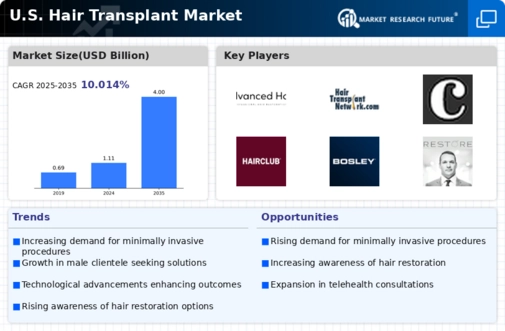The hair transplant market is currently characterized by a dynamic competitive landscape, driven by increasing consumer awareness and advancements in technology. Key players such as Bosley (US), Hair Club (US), and NewMe Health (US) are strategically positioning themselves through innovation and enhanced service offerings. Bosley (US), for instance, emphasizes its proprietary techniques and patient-centric approach, which appears to resonate well with consumers seeking personalized solutions. Meanwhile, Hair Club (US) focuses on expanding its service portfolio, integrating non-surgical options alongside traditional hair transplant procedures, thereby appealing to a broader demographic. NewMe Health (US) is leveraging digital transformation to enhance patient engagement, utilizing telehealth services to streamline consultations and follow-ups, which may significantly improve customer satisfaction and retention.
The business tactics employed by these companies reflect a moderately fragmented market structure, where localized strategies and supply chain optimization play crucial roles. Companies are increasingly localizing their operations to better cater to regional preferences and regulatory requirements. This localized approach, combined with strategic partnerships, allows for a more agile response to market demands, thereby enhancing competitive positioning. The collective influence of these key players shapes a landscape where innovation and customer experience are paramount, driving the overall growth of the market.
In October 2025, Bosley (US) announced a partnership with a leading telehealth platform to enhance its remote consultation capabilities. This strategic move is likely to bolster its market presence by making hair restoration services more accessible to a wider audience, particularly those hesitant to visit clinics in person. By integrating telehealth, Bosley (US) not only addresses current consumer preferences for convenience but also positions itself as a forward-thinking leader in the industry.
In September 2025, Hair Club (US) launched a new line of non-surgical hair restoration products aimed at younger consumers. This initiative appears to be a calculated effort to capture a demographic that may not yet be considering surgical options. By diversifying its offerings, Hair Club (US) is likely to enhance its market share and establish a stronger foothold among millennials and Gen Z, who are increasingly concerned with hair health and aesthetics.
In August 2025, NewMe Health (US) introduced an AI-driven platform for personalized hair restoration plans. This innovative approach suggests a significant shift towards data-driven decision-making in the industry. By utilizing AI, NewMe Health (US) can offer tailored solutions that may improve treatment outcomes and customer satisfaction, thereby reinforcing its competitive edge in a crowded market.
As of November 2025, the hair transplant market is witnessing trends such as digitalization, sustainability, and the integration of AI technologies. These trends are reshaping competitive dynamics, with companies increasingly forming strategic alliances to enhance their service offerings and operational efficiencies. The shift from price-based competition to a focus on innovation and technology is evident, as companies strive to differentiate themselves through superior customer experiences and reliable supply chains. Looking ahead, it seems that the competitive landscape will continue to evolve, with a strong emphasis on technological advancements and personalized services driving future growth.



















Leave a Comment